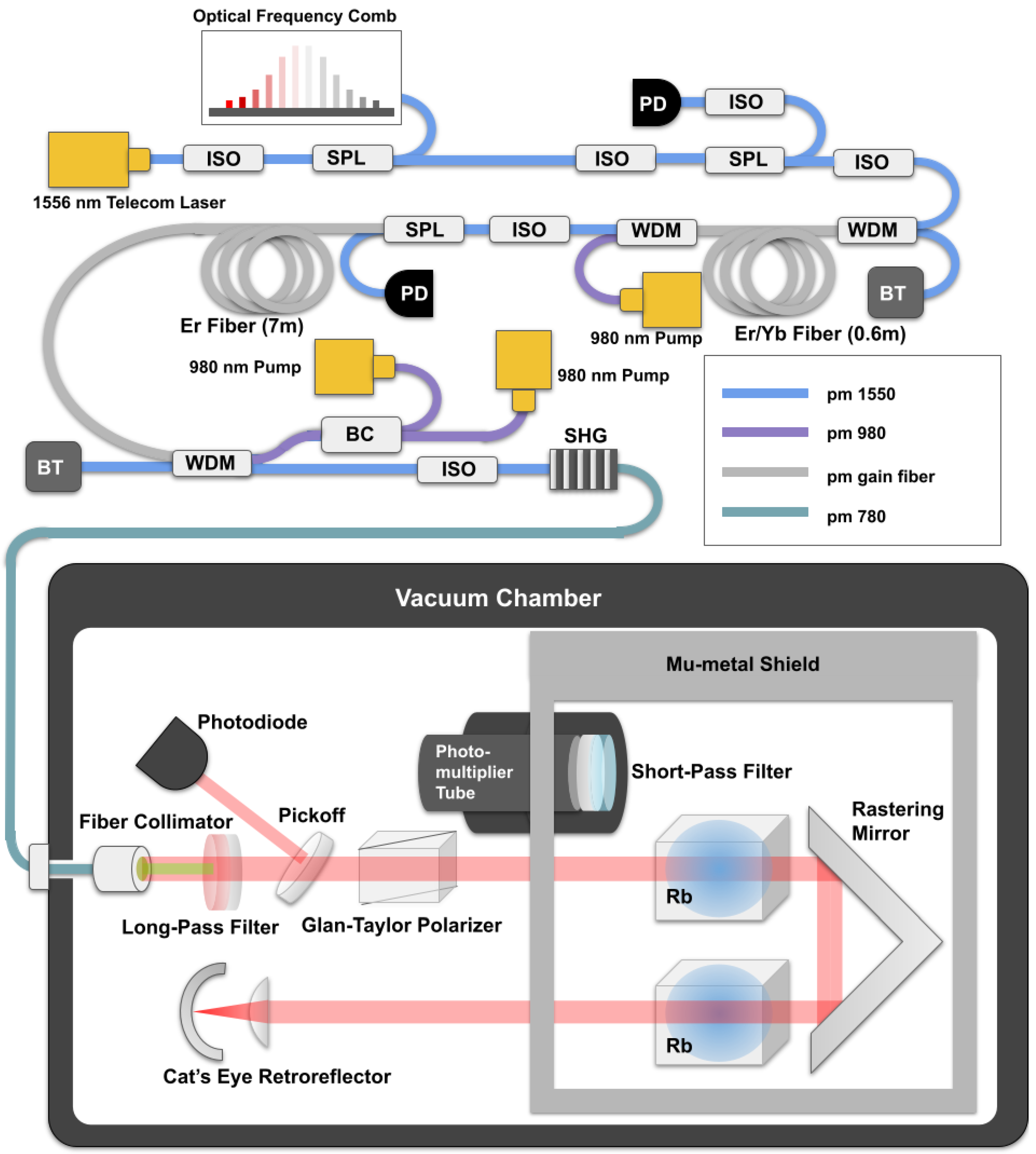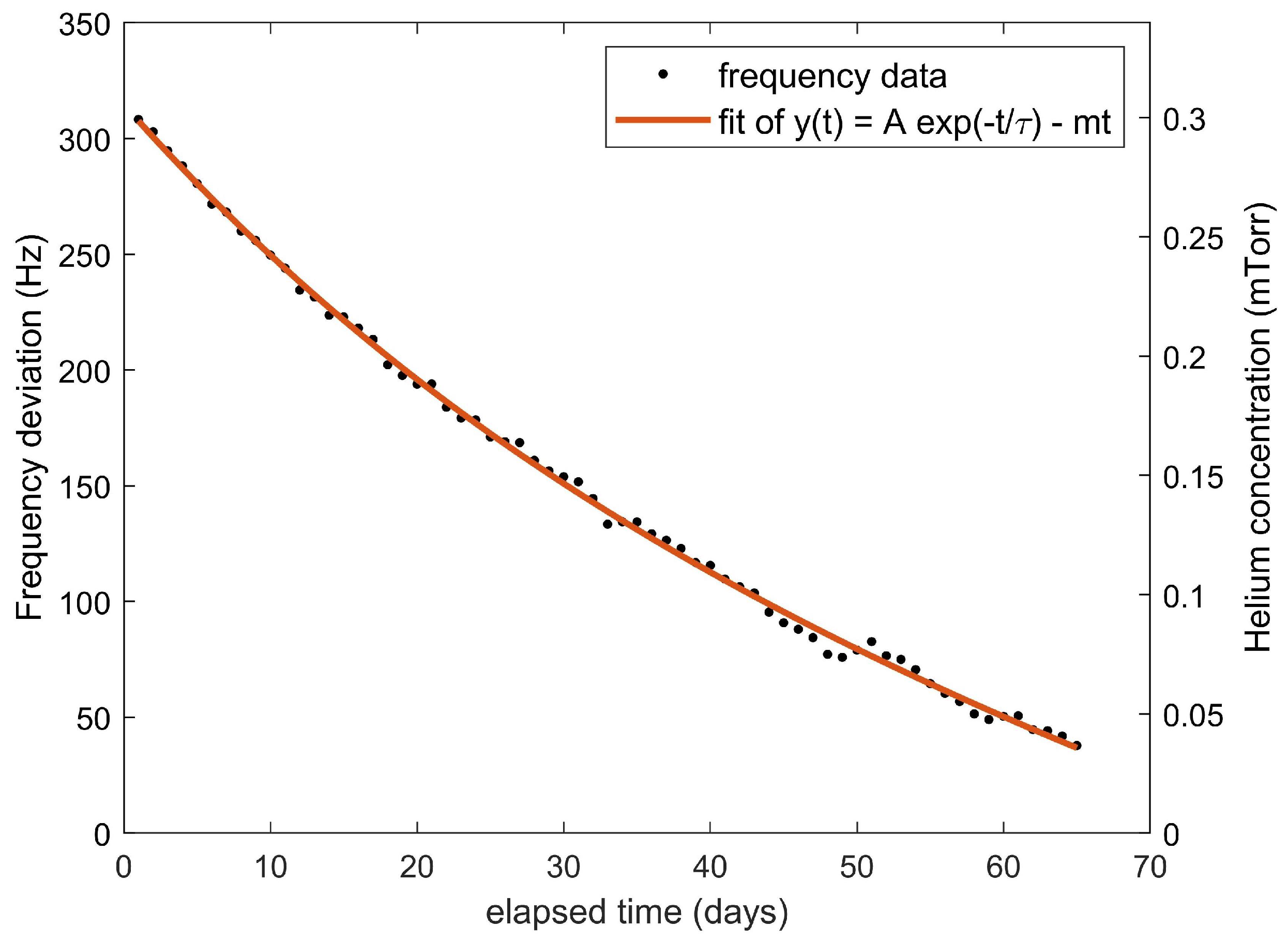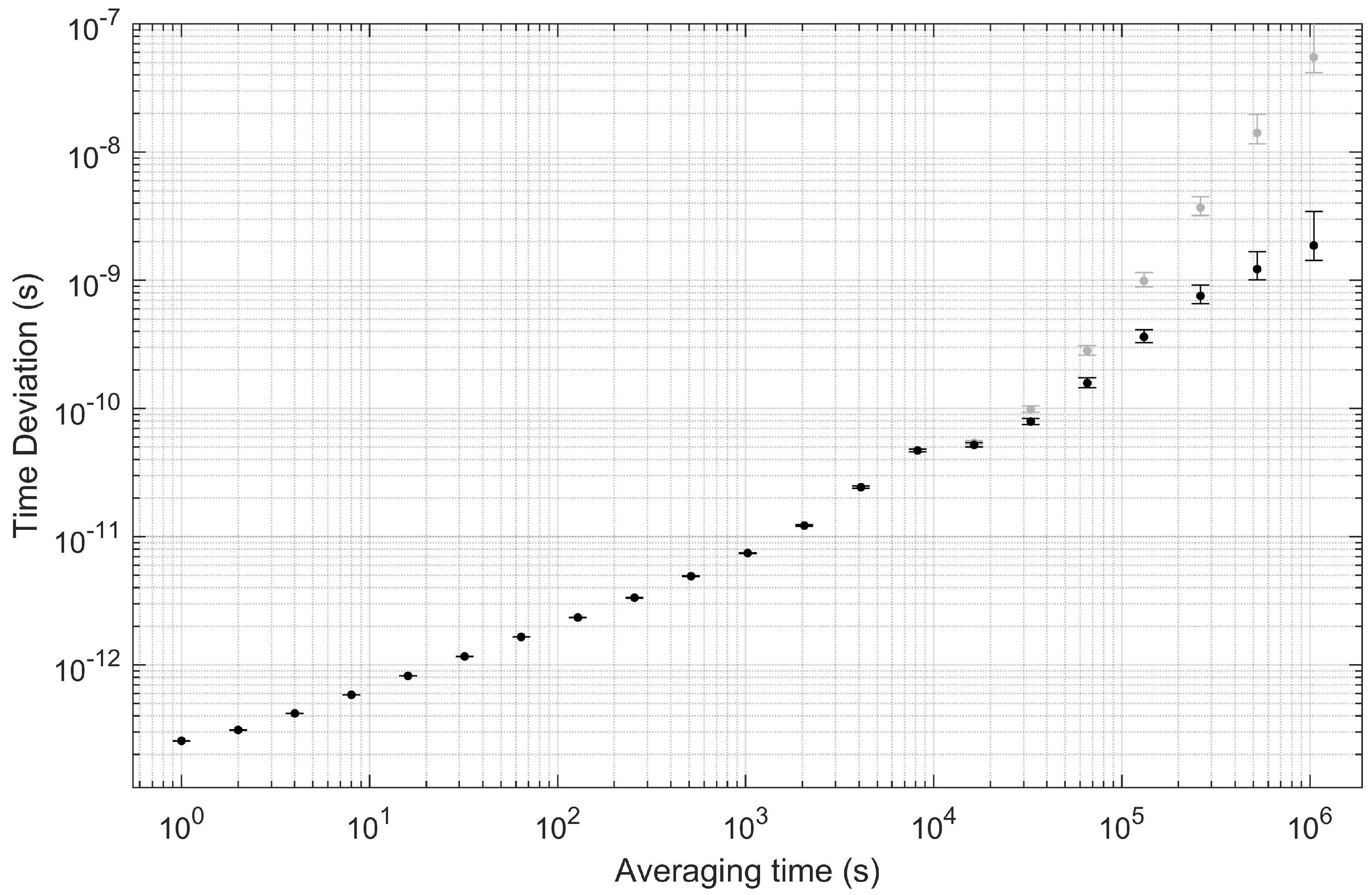Measurement of Optical Rubidium Clock Frequency Spanning 65 Days
Abstract
:1. Introduction
2. Materials and Methods
3. Results
3.1. Calibrating the Hydrogen Maser
3.2. Helium Permeation
3.3. Optical Clock Stability
3.4. Absolute Frequency
4. Discussion
Author Contributions
Funding
Institutional Review Board Statement
Informed Consent Statement
Data Availability Statement
Acknowledgments
Conflicts of Interest
References
- Beloy, K.; Bodine, M.I.; Bothwell, T.; Brewer, S.M.; Bromley, S.L.; Chen, J.S.; Deschênes, J.D.; Diddams, S.A.; Fasano, R.J.; Fortier, T.M.; et al. Frequency Ratio Measurements with 18-digit Accuracy Using a Network of Optical Clocks. Nature 2021, 591, 564–569. [Google Scholar]
- Sanner, C.; Huntemann, N.; Lange, R.; Tamm, C.; Peik, E.; Safronova, M.S.; Porsev, S.G. Optical clock comparison for Lorentz symmetry testing. Nature 2019, 567, 204–208. [Google Scholar] [CrossRef] [PubMed] [Green Version]
- Takamoto, M.; Ushijima, I.; Ohmae, N.; Yahagi, T.; Kokado, K.; Shinkai, H.; Katori, H. Test of general relativity by a pair of transportable optical lattice clocks. Nat. Photonics 2020, 14, 411–415. [Google Scholar] [CrossRef]
- McNeff, J. The global positioning system. IEEE Trans. Microw. Theory Tech. 2002, 50, 645–652. [Google Scholar] [CrossRef]
- Ai, Q.; Yuan, Y.; Xu, T.; Zhang, B. Time and frequency characterization of GLONASS and Galileo on-board clocks. Meas. Sci. Technol. 2020, 31, 065003. [Google Scholar] [CrossRef]
- Angélil, R.; Saha, P.; Bondarescu, R.; Jetzer, P.; Schärer, A.; Lundgren, A. Spacecraft clocks and relativity: Prospects for future satellite missions. Phys. Rev. D 2014, 89, 064067. [Google Scholar] [CrossRef] [Green Version]
- Coffer, J.; Camparo, J. Long-term stability of a rubidium atomic clock in geosynchronous orbit. In Proceedings of the 31th Annual Precise Time and Time Interval Systems and Applications Meeting, Dana Point, CA, USA, 7–9 December 1999; pp. 65–74. [Google Scholar]
- Döringshoff, K.; Gutsch, F.B.; Schkolnik, V.; Kürbis, C.; Oswald, M.; Pröbster, B.; Kovalchuk, E.V.; Bawamia, A.; Smol, R.; Schuldt, T.; et al. Iodine Frequency Reference on a Sounding Rocket. Phys. Rev. Appl. 2019, 11, 054068. [Google Scholar] [CrossRef]
- Nez, F.; Biraben, F.; Felder, R.; Millerioux, Y. Optical frequency determination of the hyperfine components of the 5S12-5D32 two-photon transitions in rubidium. Opt. Commun. 1993, 102, 432–438. [Google Scholar] [CrossRef]
- Edwards, C.S.; Barwood, G.P.; Margolis, H.S.; Gill, P.; Rowley, W.R.C. Development and absolute frequency measurement of a pair of 778nm two-photon rubidium standards. Metrologia 2005, 42, 464–467. [Google Scholar] [CrossRef]
- Perrella, C.; Light, P.; Anstie, J.; Baynes, F.; White, R.; Luiten, A. Dichroic Two-Photon Rubidium Frequency Standard. Phys. Rev. Appl. 2019, 12, 054063. [Google Scholar] [CrossRef]
- Maurice, V.; Newman, Z.L.; Dickerson, S.; Rivers, M.; Hsiao, J.; Greene, P.; Mescher, M.; Kitching, J.; Hummon, M.T.; Johnson, C. Miniaturized optical frequency reference for next-generation portable optical clocks. Opt. Express 2020, 28, 24708–24720. [Google Scholar] [CrossRef] [PubMed]
- Newman, Z.L.; Maurice, V.; Drake, T.; Stone, J.R.; Briles, T.C.; Spencer, D.T.; Fredrick, C.; Li, Q.; Westly, D.; Ilic, B.R.; et al. Architecture for the photonic integration of an optical atomic clock. Optica 2019, 6, 680–685. [Google Scholar] [CrossRef] [Green Version]
- Newman, Z.L.; Maurice, V.; Fredrick, C.; Fortier, T.; Leopardi, H.; Hollberg, L.; Diddams, S.A.; Kitching, J.; Hummon, M.T. High-performance, compact optical standard. Opt. Lett. 2021, 46, 4702–4705. [Google Scholar] [CrossRef] [PubMed]
- Grotti, J.; Koller, S.; Vogt, S.; Häfner, S.; Sterr, U.; Lisdat, C.; Denker, H.; Voigt, C.; Timmen, L.; Rolland, A.; et al. Geodesy and metrology with a transportable optical clock. Nat. Phys. 2018, 14, 437–441. [Google Scholar] [CrossRef] [Green Version]
- Morris, D.; Aldous, M.; Gellesch, M.; Jones, J.; Kale, Y.; Singh, A.; Bass, J.; Bongs, K.; Singh, Y.; Hill, I.; et al. Development of a Portable Optical Clock. In Proceedings of the 2019 Joint Conference of the IEEE International Frequency Control Symposium and European Frequency and Time Forum (EFTF/IFC), Orlando, FL, USA, 14–18 April 2019; pp. 1–3. [Google Scholar] [CrossRef]
- Ohmae, N.; Takamoto, M.; Takahashi, Y.; Kokubun, M.; Araki, K.; Hinton, A.; Ushijima, I.; Muramatsu, T.; Furumiya, T.; Sakai, Y.; et al. Transportable Strontium Optical Lattice Clocks Operated Outside Laboratory at the Level of 10–18 Uncertainty. Adv. Quantum Technol. 2021, 4, 2100015. [Google Scholar] [CrossRef]
- Huang, Y.; Zhang, H.; Zhang, B.; Hao, Y.; Guan, H.; Zeng, M.; Chen, Q.; Lin, Y.; Wang, Y.; Cao, S.; et al. Geopotential measurement with a robust, transportable Ca+ optical clock. Phys. Rev. A 2020, 102, 050802. [Google Scholar] [CrossRef]
- McConnell, R.; Aull, B.; Braje, D.; Bruzewicz, C.; Callahan, P.; Chiaverini, J.; Collins, M.; Donlon, K.; Felton, B.; Juodawlkis, P.; et al. Integrated Technologies for Portable Optical Clocks. In OSA Optical Sensors and Sensing Congress 2021 (AIS, FTS, HISE, SENSORS, ES); Optical Society of America: Washington, DC, USA, 2021; p. SW4I.1. [Google Scholar] [CrossRef]
- Manurkar, P.; Perez, E.F.; Hickstein, D.D.; Carlson, D.R.; Chiles, J.; Westly, D.A.; Baumann, E.; Diddams, S.A.; Newbury, N.R.; Srinivasan, K.; et al. Fully self-referenced frequency comb consuming 5 watts of electrical power. OSA Contin. 2018, 1, 274–282. [Google Scholar] [CrossRef]
- Pröbster, B.J.; Lezius, M.; Mandel, O.; Braxmaier, C.; Holzwarth, R. FOKUS II—Space flight of a compact and vacuum compatible dual frequency comb system. J. Opt. Soc. Am. B 2021, 38, 932–939. [Google Scholar] [CrossRef]
- Martin, K.W.; Phelps, G.; Lemke, N.D.; Bigelow, M.S.; Stuhl, B.; Wojcik, M.; Holt, M.; Coddington, I.; Bishop, M.W.; Burke, J.H. Compact Optical Atomic Clock Based on a Two-Photon Transition in Rubidium. Phys. Rev. Appl. 2018, 9, 014019. [Google Scholar] [CrossRef] [Green Version]
- Phelps, G.; Lemke, N.; Erickson, C.; Burke, J.; Martin, K. Compact Optical Clock with 5×10−13 Instability at 1 s. NAVIGATION 2018, 65, 49–54. [Google Scholar] [CrossRef]
- Numata, K.; Camp, J.; Krainak, M.A.; Stolpner, L. Performance of planar-waveguide external cavity laser for precision measurements. Opt. Express 2010, 18, 22781–22788. [Google Scholar] [CrossRef] [PubMed]
- Sinclair, L.C.; Coddington, I.; Swann, W.C.; Rieker, G.B.; Hati, A.; Iwakuni, K.; Newbury, N.R. Operation of an optically coherent frequency comb outside the metrology lab. Opt. Express 2014, 22, 6996–7006. [Google Scholar] [CrossRef] [PubMed] [Green Version]
- Zhang, W.; Martin, M.J.; Benko, C.; Hall, J.L.; Ye, J.; Hagemann, C.; Legero, T.; Sterr, U.; Riehle, F.; Cole, G.D.; et al. Reduction of residual amplitude modulation to 1 × 10−6 for frequency modulation and laser stabilization. Opt. Lett. 2014, 39, 1980–1983. [Google Scholar] [CrossRef] [PubMed]
- du Burck, F.; Lopez, O. Correction of the distortion in frequency modulation spectroscopy. Meas. Sci. Technol. 2004, 15, 1327–1336. [Google Scholar] [CrossRef]
- Rogers, W.A.; Buritz, R.S.; Alpert, D. Diffusion Coefficient, Solubility, and Permeability for Helium in Glass. J. Appl. Phys. 1954, 25, 868–875. [Google Scholar] [CrossRef]
- Altemose, V.O. Helium Diffusion through Glass. J. Appl. Phys. 1961, 32, 1309–1316. [Google Scholar] [CrossRef]
- Zameroski, N.D.; Hager, G.D.; Erickson, C.J.; Burke, J.H. Pressure broadening and frequency shift of the 5S1/2→ 5D5/2and 5S1/2→ 7S1/2two photon transitions in85Rb by the noble gases and N2. J. Phys. At. Mol. Opt. Phys. 2014, 47, 225205. [Google Scholar] [CrossRef]
- Rushton, J.A.; Aldous, M.; Himsworth, M.D. Contributed Review: The feasibility of a fully miniaturized magneto-optical trap for portable ultracold quantum technology. Rev. Sci. Instrum. 2014, 85, 121501. [Google Scholar] [CrossRef] [Green Version]
- Dellis, A.T.; Shah, V.; Donley, E.A.; Knappe, S.; Kitching, J. Low helium permeation cells for atomic microsystems technology. Opt. Lett. 2016, 41, 2775–2778. [Google Scholar] [CrossRef]
- Norton, F.J. Helium Diffusion through Glass. J. Am. Ceram. Soc. 1953, 36, 90–96. [Google Scholar] [CrossRef]
- Shelby, J. Helium Diffusivity and Solubility in K2O-SiO2 Glasses. J. Am. Ceram. Soc. 1973, 57, 260–263. [Google Scholar] [CrossRef]
- Howe, D. The total deviation approach to long-term characterization of frequency stability. IEEE Trans. Ultrason. Ferroelectr. Freq. Control 2000, 47, 1102–1110. [Google Scholar] [CrossRef] [PubMed]
- Martin, K.W.; Stuhl, B.; Eugenio, J.; Safronova, M.S.; Phelps, G.; Burke, J.H.; Lemke, N.D. Frequency shifts due to Stark effects on a rubidium two-photon transition. Phys. Rev. A 2019, 100, 023417. [Google Scholar] [CrossRef] [Green Version]
- Alcock, C.B.; Itkin, V.P.; Horrigan, M.K. Vapour Pressure Equations for the Metallic Elements: 298–2500K. Can. Metall. Q. 1984, 23, 309–313. [Google Scholar] [CrossRef]
- Yudin, V.; Basalaev, M.Y.; Taichenachev, A.; Pollock, J.; Newman, Z.; Shuker, M.; Hansen, A.; Hummon, M.; Boudot, R.; Donley, E.; et al. General Methods for Suppressing the Light Shift in Atomic Clocks Using Power Modulation. Phys. Rev. Appl. 2020, 14, 024001. [Google Scholar] [CrossRef]
- Mei, G.; Zhong, D.; An, S.; Zhao, F.; Qi, F.; Wang, F.; Ming, G.; Li, W.; Wang, P. Main features of space rubidium atomic frequency standard for BeiDou satellites. In Proceedings of the 2016 European Frequency and Time Forum (EFTF), York, UK, 4–7 April 2016; pp. 1–4. [Google Scholar] [CrossRef]




| Effect | Frequency Shift (Hz) | Uncertainty (Hz) |
|---|---|---|
| ac Stark shift | −183 | 55 |
| Rb–Rb collisions | −2930 | 400 |
| 2nd-order Doppler | 194 | 1 |
| Blackbody radiation | −195 | 19 |
| Gravitational redshift | 68 | 1 |
| Servo error | 0 | 1900 |
| Maser calibration | n/a | 39 |
| 1970 |
Publisher’s Note: MDPI stays neutral with regard to jurisdictional claims in published maps and institutional affiliations. |
© 2022 by the authors. Licensee MDPI, Basel, Switzerland. This article is an open access article distributed under the terms and conditions of the Creative Commons Attribution (CC BY) license (https://creativecommons.org/licenses/by/4.0/).
Share and Cite
Lemke, N.D.; Martin, K.W.; Beard, R.; Stuhl, B.K.; Metcalf, A.J.; Elgin, J.D. Measurement of Optical Rubidium Clock Frequency Spanning 65 Days. Sensors 2022, 22, 1982. https://doi.org/10.3390/s22051982
Lemke ND, Martin KW, Beard R, Stuhl BK, Metcalf AJ, Elgin JD. Measurement of Optical Rubidium Clock Frequency Spanning 65 Days. Sensors. 2022; 22(5):1982. https://doi.org/10.3390/s22051982
Chicago/Turabian StyleLemke, Nathan D., Kyle W. Martin, River Beard, Benjamin K. Stuhl, Andrew J. Metcalf, and John D. Elgin. 2022. "Measurement of Optical Rubidium Clock Frequency Spanning 65 Days" Sensors 22, no. 5: 1982. https://doi.org/10.3390/s22051982
APA StyleLemke, N. D., Martin, K. W., Beard, R., Stuhl, B. K., Metcalf, A. J., & Elgin, J. D. (2022). Measurement of Optical Rubidium Clock Frequency Spanning 65 Days. Sensors, 22(5), 1982. https://doi.org/10.3390/s22051982






